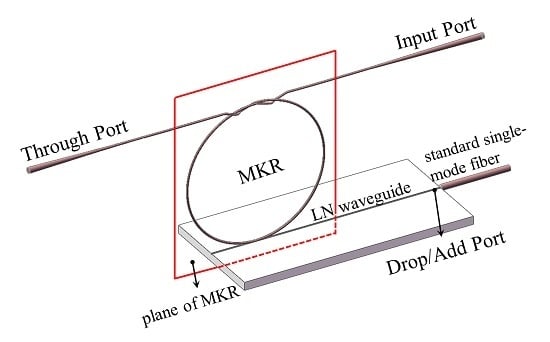Add-Drop Filter Based on Wavelength-Dependent Light Interlink between Lithium-Niobate Microwaveguide Chip and Microfiber Knot Ring
Abstract
:1. Introduction
2. Results and Discussions
2.1. Drop Functionality and Its Performance Dependence on Microfiber Knot Ring Diameter
2.2. Add Functionality and Its Performance Dependence on Microfiber Knot Ring Diameter
2.3. Polarization-Dependent Loss
3. Materials and Methods
3.1. Fabrication of Microfiber Knot Ring
3.2. Lithium Niobate Microwaveguide
3.3. Coupling Process of Experiment
4. Conclusions
Acknowledgments
Author Contributions
Conflicts of Interest
Abbreviations
| LN | lithium niobate |
| MKR | microfiber knot ring |
| MNOF | micro/nano optical fiber |
| APE | annealed proton exchange |
| FSR | free spectral range |
| PDL | polarization dependent loss |
| OSA | optical spectral analyzer |
| TLS | tunable laser source |
References
- Tong, L.M.; Gattass, R.R.; Ashcom, J.B.; He, S.L.; Lou, J.Y.; Shen, M.Y.; Maxwell, I.; Mazur, E. Subwavelength-diameter silica wires for low-loss optical wave guiding. Nature 2003, 426, 816–819. [Google Scholar] [CrossRef] [PubMed]
- Jiang, X.S.; Yang, Q.; Vienne, G.; Li, Y.H.; Tong, L.M.; Zhang, J.J.; Hu, L.L. Demonstration of microfiber knot laser. Appl. Phys. Lett. 2006, 89, 143513. [Google Scholar] [CrossRef]
- Jiang, X.S.; Song, Q.H.; Xu, L.; Fu, J.; Tong, L.M. Microfiber knot dye laser based on the evanescent-wave-coupled gain. Appl. Phys. Lett. 2007, 90, 233501. [Google Scholar] [CrossRef]
- Arjmand, M.; Ahmadi, V.; Karimi, M. Wavelength-selective optical amplifier based on microfiber coil resonators. J. Lightwave Technol. 2012, 30, 2596–2602. [Google Scholar] [CrossRef]
- Yuhang, L.; Limin, T. Mach-zehnder interferometers assembled with optical microfibers or nanofibers. Opt. Lett. 2008, 33, 303–305. [Google Scholar]
- Sulaiman, A.; Harun, S.W.; Ahmad, F.; Muhammad, M.Z.; Jasim, A.A.; Ahmad, H. Demonstration of microfiber hybrid mach–zehnder and knot resonator structure. Microwave Opt. Technol. Lett. 2013, 55, 100–102. [Google Scholar] [CrossRef]
- Wu, Y.; Rao, Y.J.; Chen, Y.H.; Gong, Y. Miniature fiber-optic temperature sensors based on silica/polymer microfiber knot resonators. Opt. Express 2009, 17, 18142–18147. [Google Scholar] [CrossRef] [PubMed]
- Sumetsky, M. Optical fiber microcoil resonators. Opt. Express 2004, 12, 2303–2316. [Google Scholar] [CrossRef] [PubMed]
- Sumetsky, M. Basic elements for microfiber photonics: Micro/nanofibers and microfiber coil resonators. J. Lightwave Technol. 2008, 26, 21–27. [Google Scholar] [CrossRef]
- Sumetsky, M.; Dulashko, Y.; Fini, J.M.; Hale, A. Optical microfiber loop resonator. Appl. Phys. Lett. 2005, 86, 161108. [Google Scholar] [CrossRef]
- Sumetsky, M.; Dulashko, Y.; Fini, J.M.; Hale, A.; DiGiovanni, D.J. The microfiber loop resonator: Theory, experiment, and application. J. Lightwave Technol. 2006, 24, 242–250. [Google Scholar] [CrossRef]
- Jiang, X.S.; Tong, L.M.; Vienne, G.; Guo, X.; Tsao, A.; Yang, Q.; Yang, D.R. Demonstration of optical microfiber knot resonators. Appl. Phys. Lett. 2006, 88, 223501. [Google Scholar] [CrossRef]
- Xiao, L.M.; Birks, T.A. High finesse microfiber knot resonators made from double-ended tapered fibers. Opt. Lett. 2011, 36, 1098–1100. [Google Scholar] [CrossRef] [PubMed]
- Jiang, X.D.; Chen, Y.; Vienne, G.; Tong, L.M. All-fiber add-drop filters based on microfiber knot resonators. Opt. Lett. 2007, 32, 1710–1712. [Google Scholar] [CrossRef] [PubMed]
- Yu, J.H.; Jin, S.S.; Wei, Q.S.; Zang, Z.G.; Lu, H.H.; He, X.L.; Luo, Y.H.; Tang, J.Y.; Zhang, J.; Chen, Z. Hybrid optical fiber add-drop filter based on wavelength dependent light coupling between micro/nano fiber ring and side-polished fiber. Sci. Rep. 2015, 5, 7710. [Google Scholar] [CrossRef] [PubMed]
- Lu, H.H.; Sadani, B.; Ulliac, G.; Guyot, C.; Courjal, N.; Collet, M.; Baida, F.I.; Bernal, M.P. Integrated temperature sensor based on an enhanced pyroelectric photonic crystal. Opt. Express 2013, 21, 16311–16318. [Google Scholar] [CrossRef] [PubMed]
- Yim, Y.S.; Shin, S.Y. Lithium niobate integrated-optic voltage sensor with variable sensing ranges. Opt. Commun. 1998, 152, 225–228. [Google Scholar] [CrossRef]
- Becker, R.A. Comparison of guided-wave interferometric modulators fabricated on linbo3 via Ti indiffusion and proton exchange. Appl. Phys. Lett. 1983, 43, 131–133. [Google Scholar] [CrossRef]
- Fukunishi, S.; Uchida, N.; Miyazawa, S.; Noda, J. Electro-optic modulation of optical guided wave in linbo 3 thin film fabricated by egm method. Appl. Phys. Lett. 1974, 24, 424–426. [Google Scholar] [CrossRef]
- Wooten, E.L.; Kissa, K.M.; Yi-Yan, A.; Murphy, E.J.; Lafaw, D.A.; Hallemeier, P.F.; Maack, D.; Attanasio, D.V.; Fritz, D.J.; McBrien, G.J.; et al. A review of lithium niobate modulators for fiber-optic communications systems. IEEE J. Sel. Top. Quantum Electron. 2000, 6, 69–82. [Google Scholar] [CrossRef]
- Lu, H.H.; Qiu, W.T.; Guyot, C.; Ulliac, G.; Merolla, J.M.; Baida, F.; Bernal, M.P. Optical and RF characterization of a lithium niobate photonic crystal modulator. IEEE Photon. Technol. Lett. 2014, 26, 1332–1335. [Google Scholar] [CrossRef]
- Wu, X.X.; Peng, W.R.; Arbab, V.; Wang, J.; Willner, A. Tunable optical wavelength conversion of OFDM signal using a periodically-poled lithium niobate waveguide. Opt. Express 2009, 17, 9177–9182. [Google Scholar] [CrossRef] [PubMed]
- Lee, Y.W.; Fan, F.C.; Huang, Y.C.; Gu, B.Y.; Dong, B.Z.; Chou, M.H. Nonlinear multiwavelength conversion based on an aperiodic optical superlattice in lithium niobate. Opt. Lett. 2002, 27, 2191–2193. [Google Scholar] [CrossRef] [PubMed]
- Guarino, A.; Poberaj, G.; Rezzonico, D.; Degl’Innocenti, R.; Gunter, P. Electro-optically tunable microring resonators in lithium niobate. Nat. Photon. 2007, 1, 407–410. [Google Scholar] [CrossRef]
- Wang, C.; Burek, M.J.; Lin, Z.; Atikian, H.A.; Venkataraman, V.; Huang, I.C.; Stark, P.; Loncar, M. Integrated high quality factor lithium niobate microdisk resonators. Opt. Express 2014, 22, 30924–30933. [Google Scholar] [CrossRef] [PubMed]
- Latawiec, P.; Burek, M.J.; Venkataraman, V.; Lončar, M. Waveguide-loaded silica fibers for coupling to high-index micro-resonators. Appl. Phys. Lett. 2015, 108, 031103. [Google Scholar] [CrossRef]
- Lu, H.; Sadani, B.; Ulliac, G.; Courjal, N.; Guyot, C.; Merolla, J.M.; Collet, M.; Baida, F.I.; Bernal, M.P. 6-micron interaction length electro-optic modulation based on lithium niobate photonic crystal cavity. Opt. Express 2012, 20, 20884–20893. [Google Scholar] [CrossRef] [PubMed]
- Lu, H.; Sadani, B.; Courjal, N.; Ulliac, G.; Smith, N.; Stenger, V.; Collet, M.; Baida, F.I.; Bernal, M.P. Enhanced electro-optical lithium niobate photonic crystal wire waveguide on a smart-cut thin film. Opt. Express 2012, 20, 2974–2981. [Google Scholar] [CrossRef] [PubMed]
- Lu, H.; Issam Baida, F.; Ulliac, G.; Courjal, N.g.; Collet, M.; Bernal, M.-P. Lithium niobate photonic crystal wire cavity: Realization of a compact electro-optically tunable filter. Appl. Phys. Lett. 2012, 101, 151117. [Google Scholar] [CrossRef]
- Wang, Y.; Chen, Z.; Zhou, S.; Yu, J.; Zeng, Y.; Luo, Y.; Zhang, J.; Tang, J.; Guan, H.; Lu, H. Theoretical analysis of optical mode deflection in lithium niobate waveguide with serrated array electrodes. Opt. Quantum Electron. 2016, 48, 162. [Google Scholar] [CrossRef]
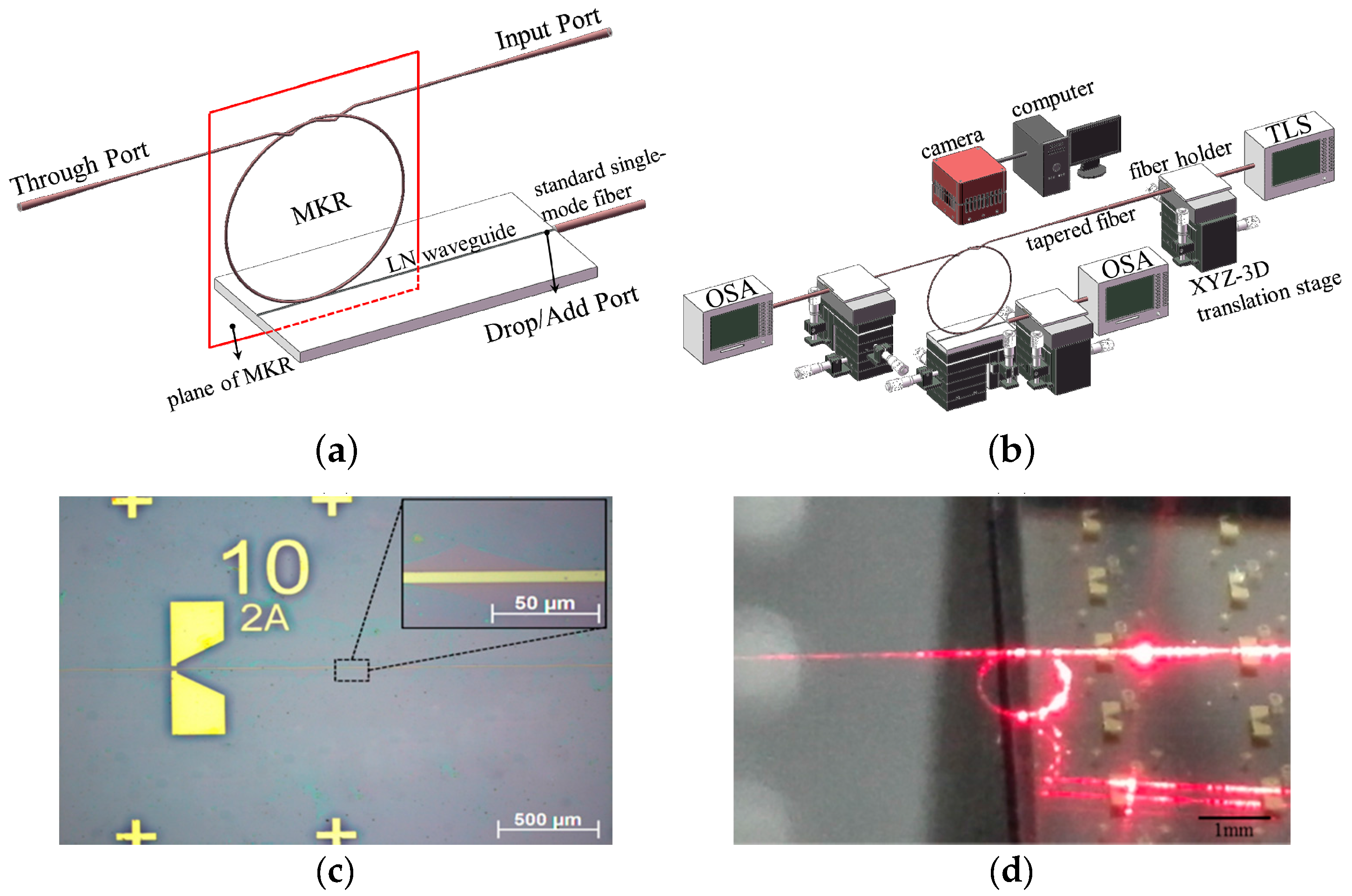
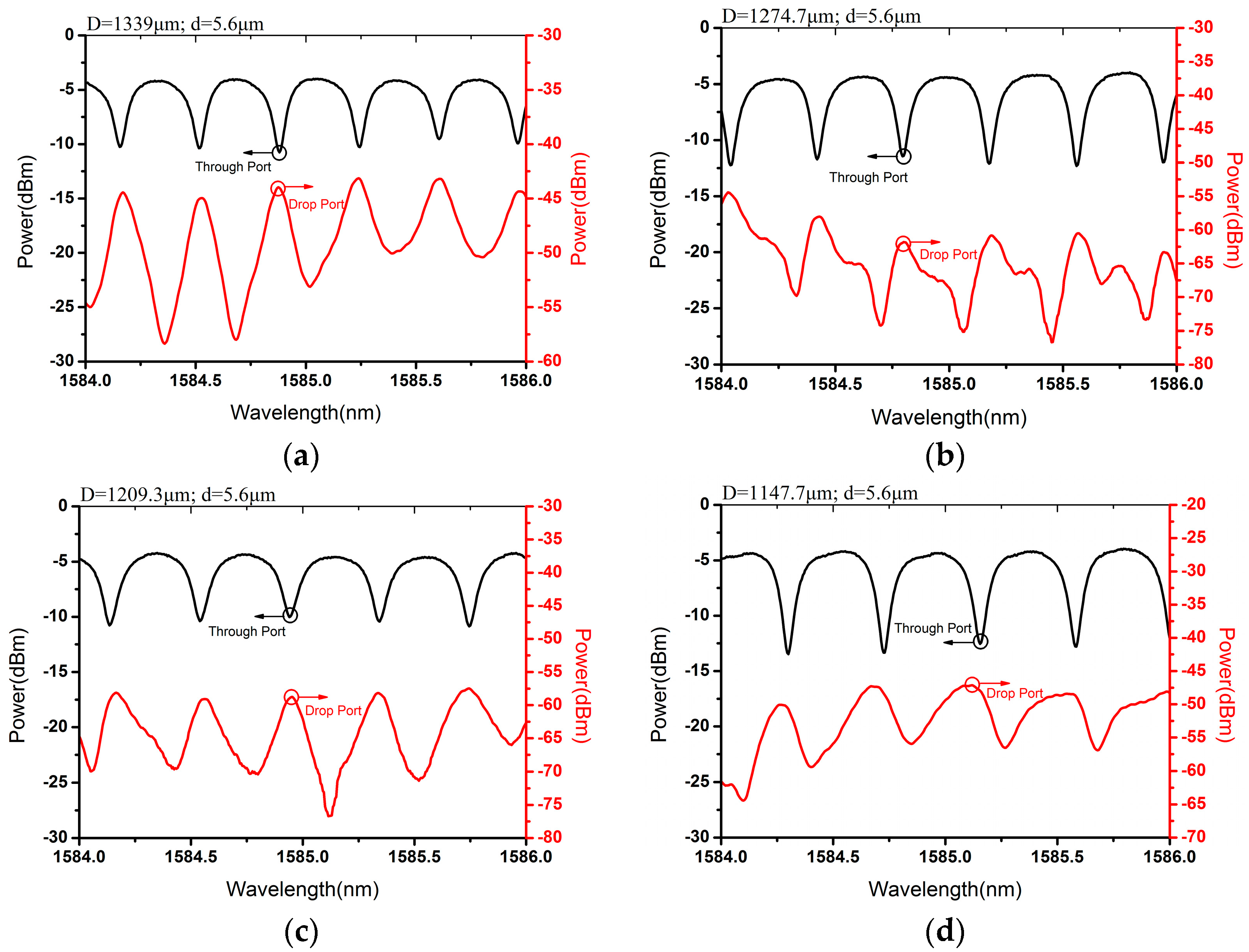
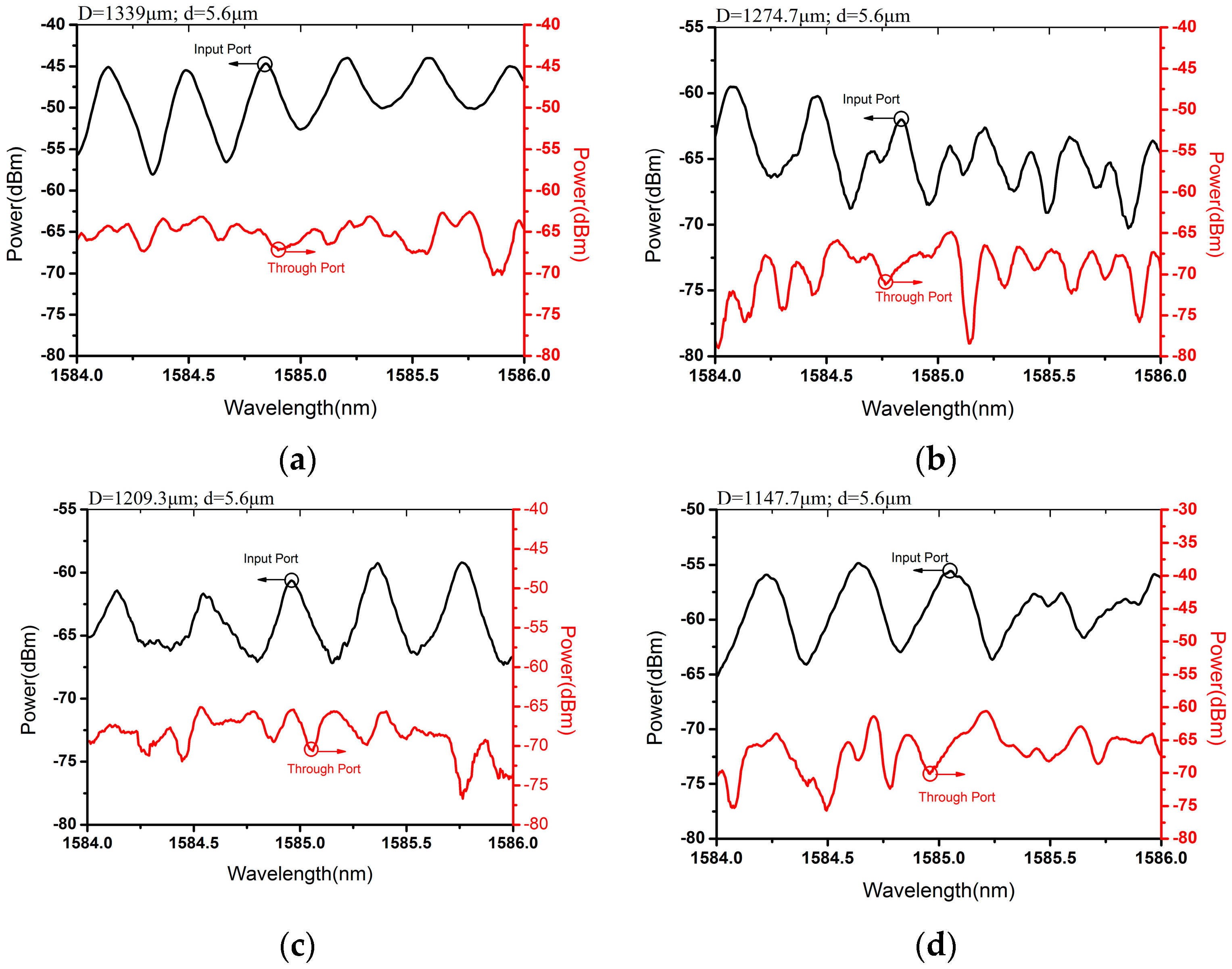
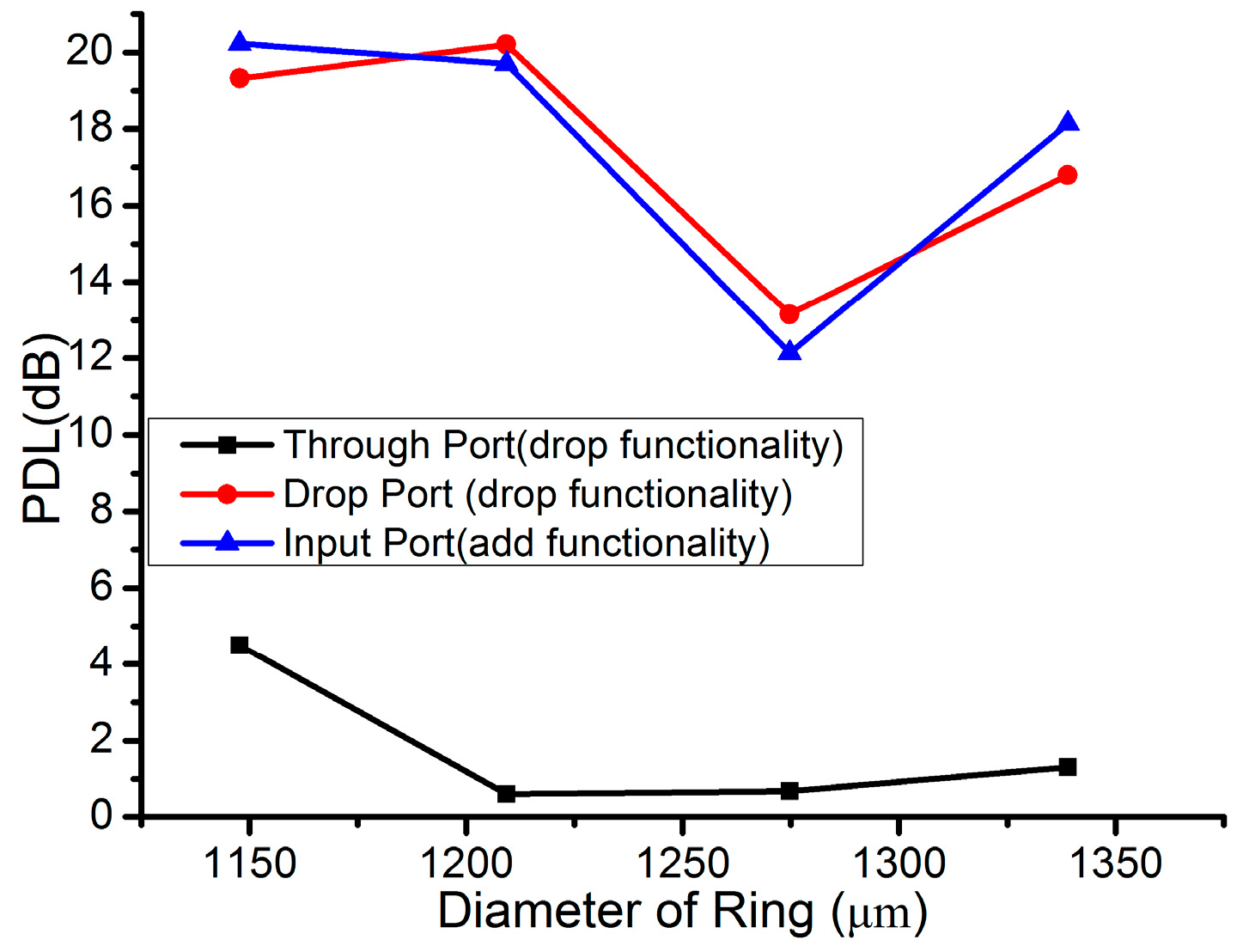
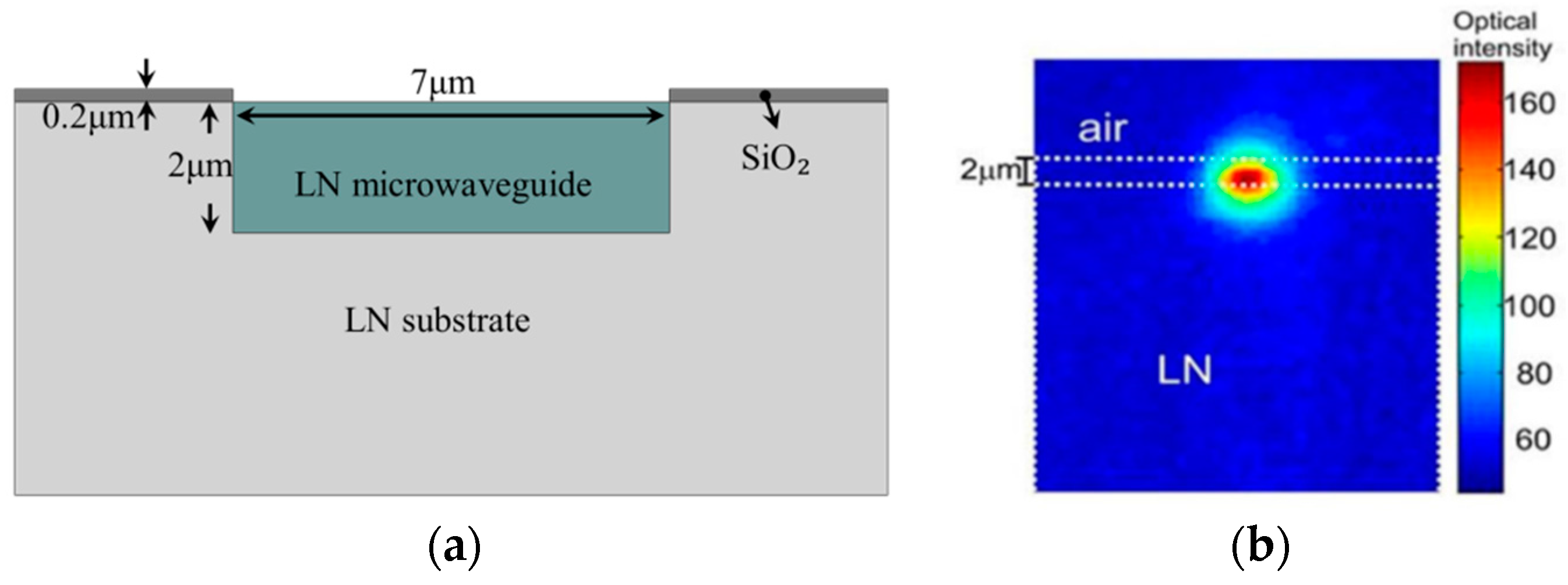
© 2016 by the authors; licensee MDPI, Basel, Switzerland. This article is an open access article distributed under the terms and conditions of the Creative Commons Attribution (CC-BY) license (http://creativecommons.org/licenses/by/4.0/).
Share and Cite
Zhou, S.; Wang, Y.; He, D.; Hu, Y.; Yu, J.; Chen, Z.; Guan, H.; Zhang, J.; Luo, Y.; Tang, J.; et al. Add-Drop Filter Based on Wavelength-Dependent Light Interlink between Lithium-Niobate Microwaveguide Chip and Microfiber Knot Ring. Crystals 2016, 6, 67. https://doi.org/10.3390/cryst6060067
Zhou S, Wang Y, He D, Hu Y, Yu J, Chen Z, Guan H, Zhang J, Luo Y, Tang J, et al. Add-Drop Filter Based on Wavelength-Dependent Light Interlink between Lithium-Niobate Microwaveguide Chip and Microfiber Knot Ring. Crystals. 2016; 6(6):67. https://doi.org/10.3390/cryst6060067
Chicago/Turabian StyleZhou, Suxu, Yuan Wang, Donghui He, Yang Hu, Jianhui Yu, Zhe Chen, Heyuan Guan, Jun Zhang, Yunhan Luo, Jieyuan Tang, and et al. 2016. "Add-Drop Filter Based on Wavelength-Dependent Light Interlink between Lithium-Niobate Microwaveguide Chip and Microfiber Knot Ring" Crystals 6, no. 6: 67. https://doi.org/10.3390/cryst6060067




